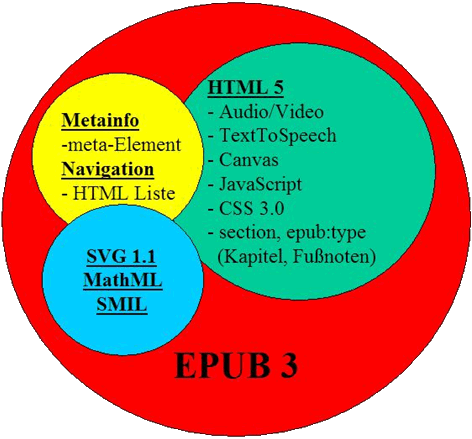Epub3
Die neue Version des Standardformats für elektronische Publikationen
Erweiterte multimediale Möglichkeiten in EPub3
Durch innovative Publikationen beginnt sich die bereits im November 2011 veröffentlichte Spezifikation Version 3 des EPub Formats zu verbreiten. Nachdem die komplette und korrekte Darstellung von in EPub2 erstellten elektronischen Büchern durch Reader und Software, von der spezialisierten APP bis zum Browser Plug In, zur Grundausstattung gehört, steigt der Anteil an Unterstützung von interaktiven und multimedialen Features in den Readern. In der Spezifikation von EPub3 ersetzt HTML5 das bisherige XHTML und bietet im Vergleich zum bisherigen Funktionsumfang beinahe revolutionär neue multimediale Möglichkeiten, die bisher nur mit proprietären Lösungen möglich waren.
 Technologien in EPUB3
Technologien in EPUB3
Neben Audio-, Sprach- (TextToSpeech) und Videoausgabe bietet HTML5 mit CSS 3.0 etwa durch das Canvas Objekt mittels JavaScript sehr flexible, interaktive und dynamische Ausgabeoptionen. Mittels simplen SMIL Statements ist eine Synchronisierung von Text und Multimedia Elementen möglich. Denkbar sind z.B. Hörbücher, Diagramme, wählbare Landkartenausschnitte usw., soweit natürlich vom Lesegerät bzw. der -software unterstützt. In die Spezifikation von EPub3 aufgenommene Technologien wie SVG oder MathML bieten höchste Qualität durch Skalierbarkeit von Grafiken und Formeln. Auch Pop-Up Fenster oder Fußnotendarstellung gehören zu den Bereichen, welche von den erweiterten technischen Möglichkeiten profitieren, z.B. durch Verwendung des aside-Tags in HTML5 und dem EPub3 spezifischen epub:type-Attribut. Optimale Verwendung von CSS 3.0 läßt abwechslungsreichere und typografisch ansprechendere Darstellung zu, welche für verschiedene Endgeräte unterschiedlich definiert werden sollte.
Containerformat für Metadaten, Navigation und Content
Im Prinzip ist eine EPub Datei eine „gepackte Webseite“ mit zusätzlichen Informationen. Das EPub Format stellt als Container neben dem Content einer Publikation Metainformationen und Informationen zur Navigation innerhalb der Dokumente zur Verfügung, um eine optimale Darstellung und ungestörten Lesefluss zu ermöglichen. Angaben zum erwünschten Rendering können auch die Darstellung hin zu einem Fixed Layout beeinflussen. Metainformationen können jetzt unkomplizierter zusätzlich in der OPF (Open Packaging Format)-Datei mittels meta-Elementen angegeben werden. Auch externe Metainfo wird möglich (etwa ONIX Datensätze). Die Navigation mittels NCX-Datei gilt als veraltet und die Verwendung eines ePUB Navigation Document (END) ermöglicht die Verwendung einer einfacheren HTML Listenstruktur. Auch Typen wie Abbildungsverzeichnisse oder Tabellenverzeichnisse können so definiert werden. HTML5 bietet zusätzliche Möglichkeiten zur Auszeichnung von semantischer Untergliederung innerhalb der Dokumente z.B. in Kapitel durch Verwendung von section- Elementen bzw. Beiträgen in Magazinen mittels article- Elementen.
<meta refines="#ID12345" property="prism:contentType">article</meta>
<meta property="dc:title" id="t4main">
Revision: Unangemessene Dauer eines finanzgerichtlichen Verfahrens. Beschränkung
des Rechtsfolgenausspruchs auf die Feststellung der Verzögerung
</meta>
<meta refines="#t4main" property="title-type">main</meta>
<meta property="dc:title" id="t4sub">
Wird ein FG in einem einfach gelagerten Klageverfahren
zwischen dem Eingang des letzten Schriftsatzes eines der Bet.
und der Anberaumung der mündlichen Verhandlung fünfeinhalb
Jahre lang -abgesehen von einer Aktenanforderung und
einer kurzen Anfrage an den Kl.- nicht tätig, ist die Verfahrensdauer
als unangemessen anzusehen.
</meta>
<meta refines="#t4sub" property="title-type">leitsatz</meta>
<meta refines="#ID12345" property="dc:creator">BFH Urteil</meta>
<meta refines="#ID12345" property="prism:genre">Entscheidung</meta>
<meta refines="#ID12345" property="CHBeck:enhancer">Beck Media Solutions</meta>
<meta refines="#ID12345" property="CHBeck:checker">rs</meta>
Rückwärtskompatibilität
Zu den Best Practices gehört es bei Publikationen trotz Verwendung von z.B. JavaScript, SVG oder MathML auch Fallbacks zum Zweck der Rückwärtskompatibilität anzubieten, z.B. durch Definition von Pixelgrafiken als Alternative. Intensives Testen vor einer Veröffentlichung von multimedialen Inhalten mit den ins Auge gefassten Zielgeräten ist unerlässlich. Beispiele für EPUB3 Publikationen gibt es im Netz.
Verfügbare Reader und Software
Den Verlagen stehen hervorragende Möglichkeiten zur Veröffentlichung und Verknüpfung von multimedialen Inhalten und Text zur Verfügung. Für einen Erfolg von neuen innovativen Konzepten ist aber auch die Verbreitung von passenden Lesegeräten Vorraussetzung. Hier steht zu erwarten, daß durch die Fähigkeiten von mobilen Geräten mit entsprechender Software ein Markt entsteht. Ebenso können Browser mit immer weiter verbesserten Funktionalitäten aufwarten. Zur Zeit ist aber kein Produkt auf dem Markt, welches EPub3 in idealer Weise oder nahezu komplett unterstützt. Nichts desto trotz ist es anzuraten rechtzeitig durch ein optimales Ausnutzen der technischen Möglichkeiten eine Veröffentlichung als E-Book noch wertvoller zu machen.
Amazon: trotz proprietärem Format wird ein Konverter von EPub3 nach KF8 angeboten
Apple: unterstützt mit iBooks wesentliche Teile der EPub3 Features
Google: keine Unterstützung von EPub 3. Aber der Play Books Reader setzt intern auf die Readium Plattform (IPDF), deshalb ist mittelfristig mit einer Verbesserung der Unterstützung zu rechnen
Adobe: bietet für E-Ink Reader Firmware bisher keine weitergehende Unterstützung von EPub 3 an, was aber zu erwarten sein wird
Unterstützung großer Anbieter für EPub3
